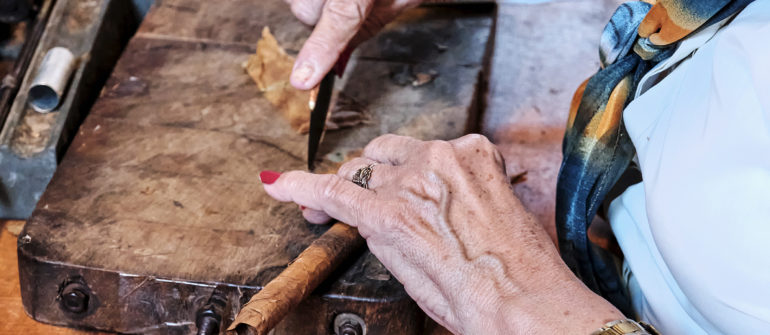The history of cigars is very much like a full-bodied stogie – rich and vibrant.
Cigar smoking has been a part of our world for over a thousand years, but not always in the same construction or style that’s widely recognized today.
We take a step back in time to show you how the art of cigar smoking has evolved through the ages, from its humble beginnings in Mayan culture to a luxury cigar market size valued at 11.61 billion USD in 2020.
THE FIRST CIGARS
In its most primitive form, a cigar is defined as a rolled bundle of tobacco that’s lit, so the smoke can be drawn into the mouth and puffs taken from it. Historians hold the general belief that the cigar was invented by the ancient Mayans, who wrapped the tobacco in palm or plantain leaves
Archaeologists can even point to the discovery of an ancient Mayan pot from the 10th century that depicts a Mayan man enjoying one of these early smokes. While this clearly indicates that smoking cigars was popular during this period (mainly as part of religious rituals), it’s unknown when the Mayans discovered the tobacco plant and its ability to be used for smoking cigars.
Connections to the indigenous people of Mexico and Central America don’t stop there. The name “cigar” itself is originally derived from the Mayan word “sikar”, which translates “to smoke rolled tobacco leaves.”
The Mayans were not alone in their unabashed enjoyment of a good cigar. Their migration unveiled tobacco to parts of the Americas as far north as Canada and south to Chile. As this pursuit became a hit with a broad swath of cultures, it was still an unknown pleasure to the Western world.
THE RISE OF TOBACCO
1492. Remember the year. Gifted navigator and courageous explorer Christopher Columbus sets off on what turns out to be a five-week voyage across the epic waves of the Atlantic. In Hispaniola (today’s Haiti and Dominican Republic), he and his crew are exposed to the smoking of tobacco leaves, and a visit to the Taínos in Cuba introduces them to the still very raw concept of a cigar.
Taking inspiration from the Mayans, the natives of Cuba would puff away on rolled-up palm leaves stuffed with dried and twisted tobacco leaves. One of Columbus’s lieutenants quickly took to this newfound habit, smoking every day on the long journey home.
They took the idea (along with tobacco seeds and leaves) back across the ocean, and it quickly caught on in Spain and Portugal. In the late 1500s, the French ambassador to Portugal, Jean Nicot, popularized cigar smoking in his home country and even had the honor of having the substance nicotine named after him.
Around this time, manufacturers in Spain started wrapping the dried tobaccos in specialized papers rather than leaves. After that, many companies started to grow their own tobacco and mass-produce cigars.
Most original European cigars were manufactured in Spain. However, it didn’t take long for them to clock on to the fertile Cuban landscape and warm climate as a perfect breeding location for tobacco plants. Columbus had claimed Cuba for Spain and they took control of the tobacco industry. They even placed a monopoly on the crop that lasted until 1817, forbidding any Cuban growers to sell to anyone but them.
The turning point that took the Cuban legend to global heights was the 1762 war between England and Spain, which resulted in Cuba’s capital being captured by the Brits for nine months. International shipping of Cuban cigars reached levels previously unimagined. Although Spain did regain control, it wasn’t enough to stop the secret of Cuban cigars from coming out. In England alone, cigars became more popular than pipes.
CIGARS AROUND THE WORLD
The conclusion of the American Revolution towards the end of the 18th century saw cigar smoking become commonplace in the United States. By the middle of the 19th century, the USA consumed approximately 300 million cigars. Many cigar manufacturers moved to Key West, Florida, and New York also became a popular destination to create cigars.
Cigars became a status symbol among the wealthy (mostly European) men who smoked them and were a part of popular culture.
Despite the embargo placed on Cuba by US President John F. Kennedy in 1962 and the subsequent 66% drop in American cigar consumption between the mid-1960s and early 1990s (according to the U.S. Department of Agriculture), the cigar boom of the mid-1990s revitalized cigars.
US citizens enjoyed top-notch handmade smokes grown in other Central American nations, namely Honduras, Colombia, and the Dominican Republic – the latter becoming the center of the cigar universe.
FAMOUS AFICIONADOS
Many of the stogies we know and love today were named after prominent figures who smoked publicly and thus helped to popularize cigars. Here are three famous cigar smokers that have been known to press a stick between their lips.
Winston Churchill
Britain’s wartime leader famously chewed on the cigar to aid his methodical process of decision-making.
The earthy, medium-bodied smoke has a hearty blend of Nicaraguan, Peruvian, and Dominican long fillers, with flavors of coffee and nuts and a short sweet spice finish.
Sylvester Stallone
The star of the Rocky and Rambo film series is another high-profile cigar lover.
Its beautiful and rustic Rosado Sungrown leaf wrapper, sublime craftsmanship, and notes of natural tobacco sweetness, cedar, earth, and lingering light spice make this smoke highly renowned by cigar connoisseurs around the world.
Arnold Schwarzenegger
From the world’s leading bodybuilder to Hollywood icon, “Arnie” smokes one to two cigars each day.
The perfect size cigar to have when he smokes his first cigar of the day after lunch would have a pleasant woody taste running through the smoke, with subtle hints of vanilla and herbal flavors.
